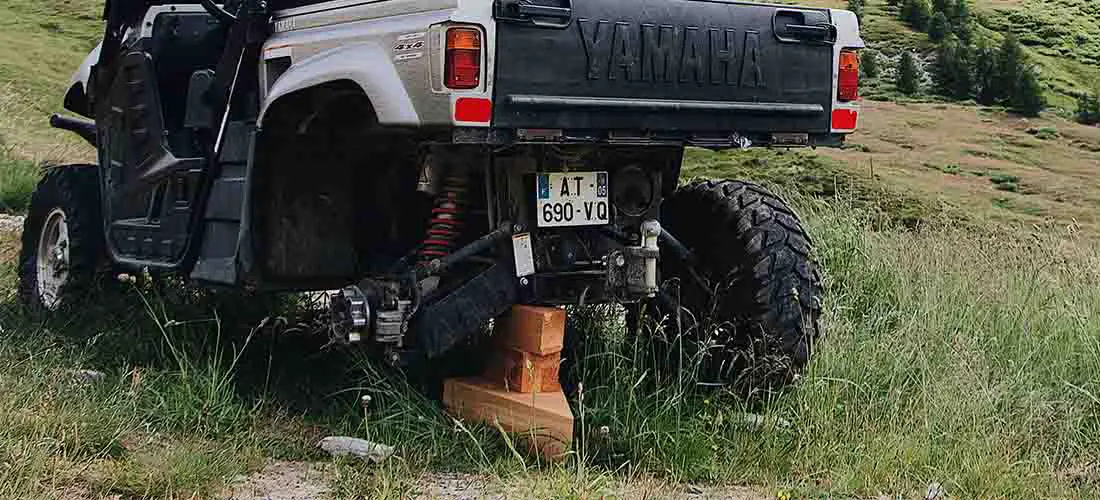Table of Contents
Keep Safety in Mind
When doing any kind of vehicle maintenance either on the road or in your garage, it is crucial to be sure to follow safety guidelines. When not done properly, it can be easy to get seriously injured when using a jack.
First and foremost, you want to check and be sure that everything is balanced stably. Each jack device will have its own safety guidelines, so make sure you are aware of them before you try and use it to lift your off-roader. We will cover the basics of most commonly used jacks and how they can best be used on UTVs.
Never rest the entire weight of your UTV on a single point. This increases the chance that it will topple over and cause injury. There are several ways to secure it. You can use multiple jacks or use materials like cinder blocks under the frame as an anchor point.
Before ever getting under your vehicle, give it a little shake. If you see significant movement, then do more to secure it. A good rule of thumb is that the lift should have one and a half times the weight capacity of your ride’s weight. Follow any instructions provided with the jack you end up using.
UTV Jack Options
Hydraulic Floor Jacks
These are long-lasting and are well worth the cost if you plan to do routine maintenance on your UTV. They are usually priced around $130 though there are a few brands that have solid cheaper options for UTVs.
Scissor Jacks
Scissor jacks are one of the most affordable options. You can get a whole kit for only $59.99, or you can purchase only the jack for less than $30. Also, this type of lift works well with UTV frames and is more likely to be stable and user friendly. The downside is that they do take slightly longer and more energy to use as the lead screw needs to be turned a lot to reach a significant height.

Scissor Jack 3,000 Lb (1.5 Ton)
UTV Jack
These are heavy-duty options that have add-ons, which make them perfect for use with UTVs. While they are more expensive, ranging up to $85.99 before adding on mount prices, they are also long-lasting and excellent quality. You can add a UTV mount for around $64.99.
Quick Jack
These are easily stored being only 13 pounds and able to lift a UTV three feet with a 2,000-pound capacity. They work best by anchoring to the front bumper or frame. The cost is a little higher at $89.95.
Table Jack
If you only want a lift for general checkup and maintenance, then this might be a bit too expensive with prices starting around $700. They are tables that lift the entire vehicle so that you can work at eye height, which is very useful for installing aftermarket additions and accessories.
Bottle Jacks
These lifts are the cheapest that you will find. The cost-saving does come with some downsides, though. They do not lift as high and require more significant space. However, for a quick tire change, they get the job done, and you can find them under $20 online.

Hydralic Bottle Jack 4,000 Lb (2 Ton)
Mini Ramps
Although you cannot do tire maintenance with these, they do allow you to lift the front or back of your vehicle so that you can fix other issues. You simply drive up the ramp, and it will enable for clearance for you to reach whatever needs to be repaired. There are many various materials and sizes to choose from for ramps, so their price can range from $39 to over $300 for a set of two.

Vehicle Mini Ramps 12,000 Lb (6 Ton)
Which Jacks are Best for UTVs
One of the lowest cost options that also happens to be the safest to use with UTVs is a scissor lift. This lift works very well with off-roading vehicles and is easy to transport with you on the trail though you will have to find a firm, even area of ground, to use it safely. Some of them also come with wheels for easy maneuvering.
UTV jacks are also ideal but tend to work better in controlled environments like a garage. A quick lift jack can also be useful if you have limited storage space on your UTV and want to bring something with you for longer trips. They are small, only weigh around 13 pounds, and are easy to use.
How to Position a Jack
When you go to lift your UTV, it will be relevant where you place the jack, especially if you are using cement blocks, a car jack, or jack stands. You want to make sure that there is not too much pressure put onto weaker areas of the UTV. When using a scissor lift or UTV jack, the connection points are not as important because there is a lower chance of damage. Below we have listed some jack positioning do’s and don’ts for you to follow.
Do
- Find an area of the frame that is appropriately balanced for use as a jack point. Another good anchor point is under the front bumper or on the axle near your UTVs rear tires. If you are using a regular car jack, it is especially important to make sure that the jack is positioned under the frame; otherwise you may significantly damage the vehicle.
Do Not
- When using a jack not designed explicitly for UTVs, avoid points on the A-Arms, rear sprockets, bottom of the engine, or rotors.
How to Jack Up Your UTV
You want always to follow instructions for your specific list make, model, and brand in regards to your vehicle because there can be some significant differences in placement, and you want to make sure it is secure. When in doubt, check the manufacturer’s guidelines online. Below we have step by step instructions for some more common lifts.
Scissor Lift/Hydraulic UTV Lifts
- Place lift under UTV. Make sure you read the instructions to make sure you have it in the right position. Each lift will be slightly different, but generally, it will be in the center of the vehicle under the frame.
- Hook up compressed air to the hose on the lift.
- This will raise the lift.
- Shake to make sure it is steady before working.
Quick Lift
- Position the jack on flat, even surface, and pull up to a height just under the front bumper and insert the pin.
- Make sure the arm is in place to lift the bumper or back axle.
- Use a drill or hand crank to raise the shaft to whatever height you need.
- To remove, reverse drill, or crank to lower the lift.
Protips for Jacking Up a UTV on the Trail
When you are out on the road and have a tire go out or some other maintenance issue that requires that you lift your UTV, it is essential to make sure you are on level ground. This can be hard to come across in certain terrains, but you do not want to compromise the stability of the vehicle when it is raised. A portable jack is a must-have for anyone that uses their UTV off-road in rough terrain or on long trips. For more information on portable lifts and what other items will come in handy on longer trips, check out our article What should I carry in my UTV.
Look for a stretch of flat, hard ground where your jack will not sink in once it takes the full weight of the vehicle. Then carefully set up your jack and make sure that everything is balanced and steady before attempting any maintenance.
Tricks for When You Have No Jack on the Trail
Sometimes flat tires happen when you are nowhere near a jack or any way to get assistance. Here are some tricks for how to expose the tire so it can be changed without the use of any devices.
Never attempt this if it appears unstable or if there is no safe space available. Safety is even more vital when you are traveling solo or are very far away from anyone who can help you if you get hurt by accident. It can help to practice these in controlled settings so that when you are required to use these methods, they will be familiar.
- Use a large rock or boulder
- Carefully roll your front tire up onto the rock keeping your back tires firmly on level ground.
- Put on a parking brake and use wood or other materials as chocks to keep it from rolling if the brake fails.
- Make sure everything is stable before attempting any kind of tire change.
- Use loose ground
- Drive the tire that needs changing over a plot of very loose soil.
- Place heavy-duty wood or blocks under the axle so that it will support the vehicle’s weight.
- Dig the soil out from under the tire to give you access.
- Check stability before attempting a tire change.
- Replace the soil when you are done.
The best thing to do is not to get caught without a portable jack.









